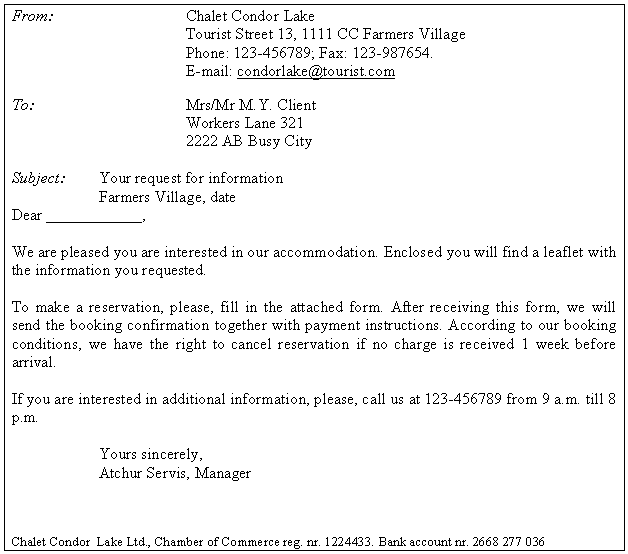






|

|

|

|

|

|
Usually your potential customers find out about your accommodation from the Internet, travel guide, an advertisement or somebody who has visited the place. However, if you have not provided sufficient information, it is most likely that they will contact you by e-mail (the most frequent way of communication nowadays), by phoneor by regular mailasking for more details.
Responding to the requests for more information,making and confirming reservations, and providing invoicesare the most frequent activities in written correspondence. Hence, it makes sense to create some standard forms that will allow you to react promptly to your clients requests.
Spend some time on developing an (electronic) information leaflet and an (electronic) standard letter – a reply to the first information request. Include some specificities of your business, and this standard form will save you a lot of time in future. The simple reply to the first information request can look like the example below, or may be done with your own personal touch.

|
Mind that at every official e-mail and regular post mail the official name of the accommodationwith address and the registration number of the Chamber of Commerce has to be mentioned. It is also easy to write down your bank account number for possible payments. If you are dealing with foreign guest an IBAN number and BIC/SWIFT code has to be added at your Bank account information.
Providing information about your accommodation, always remember that your guest’s experience starts before the visit.
The ideal option would be to have an elaborate website, with all the information that can be interesting for your potential guests. Developing such a website requires time and effort, but would save you a lot of time in the future often making your guest to skip the first contact and proceed directly to booking. See information on the contents of the website in unit 2.2. Marketing.

|
4.1. Booking and Correspondence | 4.1.2. Reservations and Payment |

|